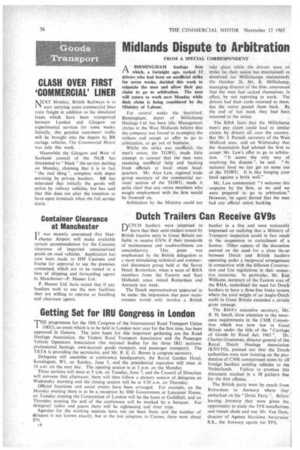Dutch Trailers C an Receive GV9s
Page 58

If you've noticed an error in this article please click here to report it so we can fix it.
nUTCH hauliers were surprised to
learn that their semi-trailers towed by British tractive units in Great Britain are liable to receive GV9s if their standards of maintenance and roadworthiness are unsatisfactory. This point was emphasized by the British delegation at a most stimulating technical and commercial discussion group held at the Savoy Hotel, Rotterdam, when a team of RHA members from the Eastern and East Midlands areas visited Rotterdam and Antwerp last week.
The Dutch representatives appeared to be under the impression that poor maintenance would only involve a British haulier in a fine and were noticeably impressed on realizing that a Ministry of Transport inspection could in fact result in the suspension or curtailment of a licence. Other aspects of the discussion centred on the need for a close tie-up between Dutch and British hauliers operating under a reciprocal arrangement in connection with the different Construction and Use regulations in their respective countries. In particular, Mr. Ken Williams, secretary of the Eastern area of the RHA, underlined the need for Dutch hauliers to have a three-line brake system where the total weight of an Anglo-Dutch outfit in Great Britain exceeded a certain gross tonnage.
The RHA's executive secretary, Mr. R. H. Insoll, drew attention to the insurance requirements in the CMR Convention which was now law in Great Britain under the title of the "Carriage of Goods by Road Act, 1965". Dr. Charles Groenman, director general of the Royal Dutch Haulage Association (KNVTO), pointed out that the Dutch authorities were now insisting on the production of CMR consignment notes by all foreign hauliers sending vehicles to the Netherlands. Failure to produce this document resulted in a 50 guilders fine for the first offence.
The British party went by coach from Rotterdam to Antwerp where they embarked on the "Done Ferry ". Before leaving Antwerp they were given the opportunity to study the TES installations and transit sheds and met Mr. Van Dam, director of Agence Maritime Anversoise S.A., the Antwerp agents for TES.
































































































































































































































































